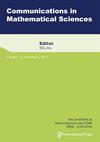初始边界值问题 Runge-Kutta 方法阶次降低的空间表现
IF 1.3
4区 数学
Q2 MATHEMATICS, APPLIED
引用次数: 0
摘要
本文研究了用高阶 Runge-Kutta 方法对初始边界值问题(IBVPs)进行时滞时出现的阶次降低的空间表现。对于这类 IBVPs,会出现 ODE IVPs 中没有的几何结构:由于内部和边界的近似误差不匹配,会出现边界层。为了理解这些边界层,我们对数值方案的模式进行了分析,从而解释了在哪些情况下边界层会在多个时间步长内持续存在。在此基础上,研究了两种减少阶次的补救措施:首先,在布彻表层上建立一个新条件,称为弱阶段阶次,与对角隐式 Runge-Kutta 方案兼容;其次,分析了修改边界条件对边界层理论的影响。本文章由计算机程序翻译,如有差异,请以英文原文为准。
Spatial manifestations of order reduction in Runge–Kutta methods for initial boundary value problems
This paper studies the spatial manifestations of order reduction that occur when timestepping initial-boundary-value problems (IBVPs) with high-order Runge–Kutta methods. For such IBVPs, geometric structures arise that do not have an analog in ODE IVPs: boundary layers appear, induced by a mismatch between the approximation error in the interior and at the boundaries. To understand those boundary layers, an analysis of the modes of the numerical scheme is conducted, which explains under which circumstances boundary layers persist over many time steps. Based on this, two remedies to order reduction are studied: first, a new condition on the Butcher tableau, called weak stage order, that is compatible with diagonally implicit Runge–Kutta schemes; and second, the impact of modified boundary conditions on the boundary layer theory is analyzed.
求助全文
通过发布文献求助,成功后即可免费获取论文全文。
去求助
来源期刊
CiteScore
1.70
自引率
10.00%
发文量
59
审稿时长
6 months
期刊介绍:
Covers modern applied mathematics in the fields of modeling, applied and stochastic analyses and numerical computations—on problems that arise in physical, biological, engineering, and financial applications. The journal publishes high-quality, original research articles, reviews, and expository papers.

 求助内容:
求助内容: 应助结果提醒方式:
应助结果提醒方式:


